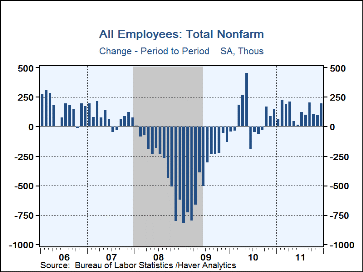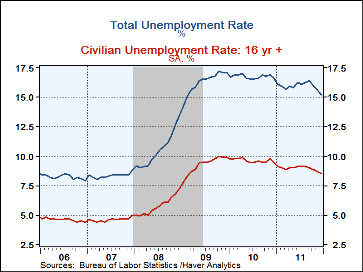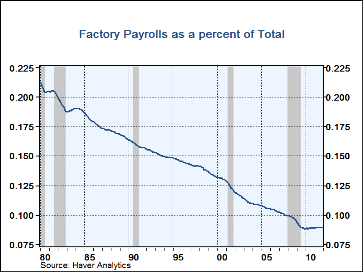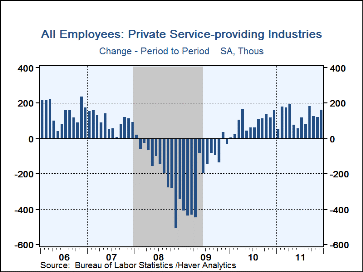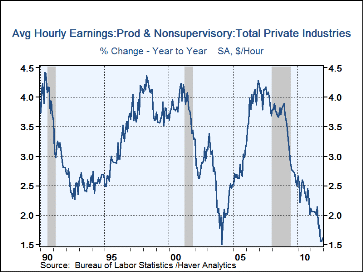 Global| Jan 06 2012
Global| Jan 06 2012U.S. Nonfarm Payrolls Post Moderate Increase; Unemployment Rate Lower
by:Tom Moeller
|in:Economy in Brief
Summary
The job market gave further indication of moderate improvement. Nonfarm payrolls grew 200,000 (1.3% y/y) in December and the prior two months were little-revised. Consensus expectations had been for a 150,000 gain in December [...]
The job market gave further indication of moderate improvement. Nonfarm payrolls grew 200,000 (1.3% y/y) in December and the prior two months were little-revised. Consensus expectations had been for a 150,000 gain in December employment. These increases were, however, still modest by the standards of past economic recoveries. In the years following earlier postwar downturns employment grew from two-to-five percent. Moreover, recent monthly increases remain weaker than the gains from February-to-April of last year. For 2011, overall payrolls grew a modest 1.0% versus the prior year's 0.7% decline. The unemployment rate slipped to 8.5% last month from 8.7% in November and was the lowest since February, 2009. Consensus expectations were for an 8.7% rate in December. For 2011, the unemployment rate of 9.0% was its lowest since 2008.
From the establishment survey, nonfarm payrolls increased 200,000 during December. The rise followed gains of 100,000 and 112,000 in November and October, revised from 120,000 and 100,000. Continuing to lead job growth was the private service sector where payrolls rose 164,000 (1.7% y/y). Retail jobs increased 27,900 (1.7% y/y). Professional & business services rose 12,000 (2.7% y/y), but temporary jobs fell 7,000 (+4.4% y/y). Education & health services also rose another, firm 29,000 (2.2% y/y) and leisure & hospitality jobs grew 21,000 (2.0% y/y). A 6,000 (-1.3% y/y) worker rise in information jobs made up for a November dip.
Manufacturing sector jobs rose 23,000 (1.9% y/y) and the gain was the strongest since July. Nevertheless factory sector jobs were just 10.7% of private nonfarm payrolls versus more than 30% during the 1960s. Construction employment rose 17,000 (0.8% y/y) after two months of decline. Continuing efforts to reduce budget deficits lowered government sector payrolls by 12,000 (-1.3% y/y). The decline reflected a 14,000 drop (-1.3% y/y) in local jobs, no change in state workers (-1.2% y/y) but a 2,000 increase in federal (-1.3% y/y) employment.
The diffusion index indicated that an improved 61.2% of private industries added jobs last month. That's the most since April but still below the Q1 figure of 65.7%. In the factory sector an improved 56.8% added jobs but that was still below 63.0% in Q1. During the last three months, 59.0% of private sector firms added jobs, the least since Q3 of last year. In manufacturing, 48.8% of firms added jobs during the last three months, the least in a year.
The length of the workweek rose to 34.4 hours and reversed its revised November dip; thus, the index of aggregate hours rose 0.5%. For Q4, the index rose at a 3.0% annual rate from Q3 after that quarter's 0.1% gain.
Average hourly earnings were unchanged following a 0.1% uptick in November. The y/y increase of 1.6% was near its all-time low and the three-month change of 1.0% was less than the 1.9% change one year earlier. Private service producing industries earnings slipped 0.1% (+1.6% y/y) due to slight monthly declines in retail (+1.1% y/y) & wholesale (+0.8% y/y) trade. Earnings increases in information (2.6% y/y), financial activities (2.4% y/y) and education & health (2.4% y/y) were moderate.
From the household survey, the unemployment rate slipped to 8.5% reflecting a 176,000 increase (1.1% y/y) in employment and a 50,000 worker decline (+0.2%% y/y) in the labor force. The overall unemployment rate including marginally attached workers and those working part time for economic reasons fell to 15.2%, down from its high two years ago of 17.2%. The average duration of unemployment remained near its high at 40.8 weeks. Within the labor force, the number of individuals not included who currently want a job fell 1.2% y/y.
The figures referenced above are available in Haver's USECON database. Additional detail can be found in the LABOR and in the EMPL databases. The expectation figures are from Action Economics and are in the AS1REPNA database.
| Employment: (M/M Chg., 000s) | Dec | Nov | Oct | Y/Y | 2011 | 2010 | 2009 |
|---|---|---|---|---|---|---|---|
| Payroll Employment | 200 | 100 | 112 | 1.3% | 1.0% | -0.7% | -4.4% |
| Previous | -- | 120 | 100 | -- | -- | -- | -- |
| Manufacturing | 23 | 1 | 10 | 1.9 | 1.7 | -2.7 | -11.6 |
| Construction | 17 | -12 | -10 | 0.8 | -0.0 | -8.1 | -16.0 |
| Private Service Producing | 164 | 126 | 128 | 1.7 | 1.6 | -0.1 | -3.5 |
| Government | -12 | -20 | -22 | -1.3 | -1.8 | -0.3 | 0.3 |
| Average Weekly Hours | 34.4 | 34.3 | 34.4 | 34.2 (Dec.'10) |
34.3 | 34.1 | 33.9 |
| Average Hourly Earnings (%) | 0.0 | 0.1 | 0.2 | 1.6 | 1.9 | 2.4 | 3.0 |
| Unemployment Rate(%) | 8.5 | 8.7 | 8.9 | 9.4 (Dec.'10) |
9.0 | 9.6 | 9.3 |
Tom Moeller
AuthorMore in Author Profile »Prior to joining Haver Analytics in 2000, Mr. Moeller worked as the Economist at Chancellor Capital Management from 1985 to 1999. There, he developed comprehensive economic forecasts and interpreted economic data for equity and fixed income portfolio managers. Also at Chancellor, Mr. Moeller worked as an equity analyst and was responsible for researching and rating companies in the economically sensitive automobile and housing industries for investment in Chancellor’s equity portfolio. Prior to joining Chancellor, Mr. Moeller was an Economist at Citibank from 1979 to 1984. He also analyzed pricing behavior in the metals industry for the Council on Wage and Price Stability in Washington, D.C. In 1999, Mr. Moeller received the award for most accurate forecast from the Forecasters' Club of New York. From 1990 to 1992 he was President of the New York Association for Business Economists. Mr. Moeller earned an M.B.A. in Finance from Fordham University, where he graduated in 1987. He holds a Bachelor of Arts in Economics from George Washington University.


